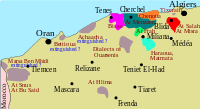Tutlayt tacenwit
(Yettusmimeḍ seg Tacenwit)
Tacenwit (s tifinaɣ: ⵜⴰⵛⵏⵡⵉⵜ) neɣ Haqbaylit d yiwet n tutlayt tamaziɣt i ttmeslayen Icenwiyen di temnaṭ n wedrar n Cenwa di Dzayer. Tutlayt tacenwit d tin i teqqnen ger n Teqbaylit yakk d trifit.
| Tacenwit | |
|---|---|
| Haqbaylit̠ | |
 | |
| Aẓaran deg | Lezzayer |
| Tamnaḍt | Tipaza, Cercal, Iyyurayen, Damus, Ayt ḥewwa, Busmaɛel, Sidi ɣilas, Tala Tagurayt, Aɣbal, Tnes, Mselmun |
At tutlayt tayemmat | 76 000 (2007)[1] |
| Ingalen n tutlayt | |
| ISO 639-3 |
cnu |
| Glottolog |
chen1266[2] |
Tcenwit d tin yettwaggzen s umihi n wengar. Acku Ur d-iqqimen ara aṭas n medden yessawalen yis tura di Lzzayer. Zik sawalen-tt di temdint n Bazar ( Tipaza), deg uɣir n Iyurayen ( Gouraya), Cercal, Sidi Ɣilas, Sidi Brahem, Nnaḍur, Damus, Ayt Ḥewwa d Brira d Bist (Bissa).
Addad amiran
ẓregImqimen s Tcenwit
ẓreg| Taqbaylit | Standalone form | n Wayla | Direct object | Indirect object | Object of preposition | Subject n wemyag deg preterite | Subject n wemyag deg Urmir | Subject n wemyag deg imperative |
|---|---|---|---|---|---|---|---|---|
| Nekkini/nekk | nečč, neččinttin | -inu | -i | -ay | -i | -aɣ | a-...-eɣ | |
| keččini/kečč | cek, cekinttin | -nnek | -c, -ic, -icek | -ak | -ek | h-...-d | ah-...-d | - |
| kemmini/kem | cem, cemminttin | -nnem | -cem, icem | -am | -em | h-...-d | ah-...-d | - |
| netta | netta, nettan | -nnes | -t, -it, -h | -as | -es | i- | ay- | |
| nettat | nettat | -nnes | -tt, -itt | -as | -es | h- | ah- | |
| nekni | necnin | -nneɣ | -negh, -ɣen | -aneɣ, -aɣen | -neɣ | n- | ann-...(-t) | |
| kenwi | kennim | -nwen | -kem, -ikem | -awen | -wen | h-...-m | ah-...-m | -t |
| kenemti | kennimtt | -nnwentt | -kemtt, -ikemtt | -awentt | -wentt | h-...-mtt | ah-...-mtt | -mtt |
| nitni | nahnin | -nsen | -ten, -iten, -hen, -ihen | -asen | -sen | -n | a-...-n | |
| nitenti | nahninţ | -nsenţ | -tentt, -itentt, -hentt, -ihentt | -asentt | -sentt | -ntt | a-...-ntt |
Tiwelhiwin
ẓreg- ↑ Tacenwit at Ethnologue (18th ed., 2015)
- ↑ Hammarström, Harald; Forkel, Robert; Haspelmath, Martin, eds. (2017). "Western Algerian Berber". Glottolog 3.0. Jena, Germany: Max Planck Institute for the Science of Human History.
| Tamaziɣt |
|---|
| Muritanya : Taẓnagt - Merruk : Tarifit | Tamaziɣt | Tasusit | Taznagt n Srayr | Tamaziɣt tudayt | Taɣumarit - Lezzayer : Taqbaylit | Tacawit | Tumẓabt | Teggargrent | Tacenwit | Iɣermawen | Tagurart - Tunes : Tasendit | Tajerbit | Tamaẓret | Dwiret - Libya : Tanfust | Twillult | Taɣdimest | Ɣat | Tasuknit | aɣarmi | Tawilant | Tazuregt - Miẓra : Isiwan - Aneẓruf : Tamahaq | Tetserret | Tayiṛt | Tawellemt | Tamaceqt - Tigzirin Tiknariyin : † Tagwanect |